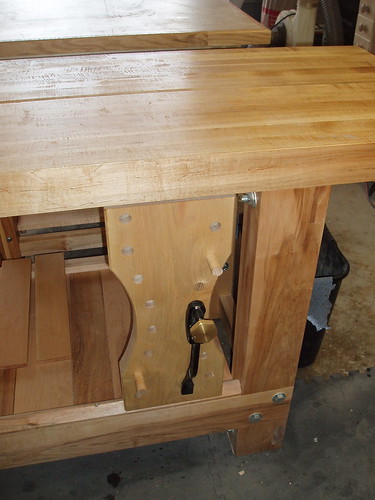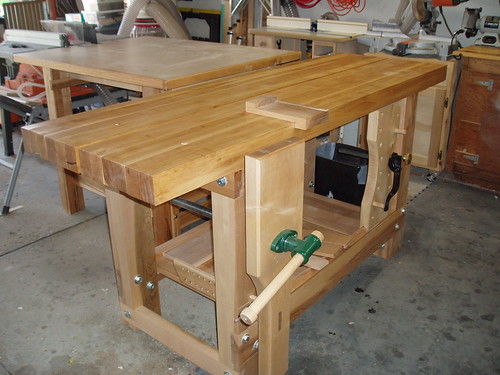Post by Safetyboy on Apr 14, 2010 21:28:44 GMT -6
Some of the guys saw pics of my new workbench in the "Shop tour" post, and asked for a tour, so here we go:
I'd been coveting workbenches for a while, but didn't quite feel I had the skills or time to make one of those really fancy ones. I knew this wouldn't be the last bench I'd ever build, and not ever having a real bench before I wasn't sure what features I'd want or need, so I didn't want to spend months and months on it. Then I saw the plans for the "Gluebo" bench in the November Popular Woodworking, and knew that was the right one.
Gluebo bench in Sketchup
The article used LVL beams as the primary wood - I used a bundle of soft maple that I had left from building my sideboard and bookcase. The base was surprisingly easy to build - I glued up the legs & stretchers from 4/4 lumber one weekend, and cut the 1/2 laps and assembled it the next.


My 6" dado stack didn't go high enough to cut the full joint out, so I actually ended up with a "true" 1/2 lap by taking a bit off the stretchers as well. 1/2 bolts through the joints are very solid, but will allow me to take the bench apart when we eventually move to a bigger house (definitely in the plans).

Then it was on to the top. I bought some 8/4 soft maple for the top, which was the most expensive part of the bench (still < $200 though). Ripped it to a bit over 3" on my Ridgid portable tablesaw - yes, you can rip 8/4 maple on that little guy! The wood was a bit wet, and sometimes would bind up past the blade and trip the fuse, but then I'd just hammer in a wedge to open it back up, and keep going. Hard maple was harder to get, so I went with soft, which is still harder (though not quite as stiff) as the yellow pine that Chris Schwartz uses in lots of his benches.
I didn't plan to make a split-top bench when I started, but once I got to 12" wide slabs, they got pretty heavy to lift up and maneuver around by myself, so I decided to leave the top in two pieces. Has some nice benefits I'll mention later. Total size is 6-feet x 24" x bit shy of 3" thick.

On to the features - the main front vise is a leg vise - first learned about that in Schwarz's Workbenches book. So far, I love it - need to plane the edge of a 12" wide panel, or make an inset door a little smaller? No problem - pinch one end in the vise, set the other on the sliding deadman, and go to town. The 10" depth is great. The pin in the parallel guide still needs a shop-made handle, but we'll get to that (who wants to teach me to turn?). The guide is fixed with my first execution of a wedged through-tennon.

The sliding deadman runs on a triangular wedge screwed to the top of the bottom stretcher, and a 3/4" groove in the bottom side of the bench. Wax it up and it slides around like a puck on ice. Veritas hold-down in the deadman for storage, or for when I need to clamp a wide piece vertically - one side in the leg vise, hold-down presses the other side against the front of the bench. In this photo you can also see the tongue-n-groove boards for the shelf under the bench - probably over-doing it, but it looks way better than a chunk of plywood sitting under there.

Planing stop on the top fits into two 3/4" holes in the benchtop. Another stop fits into the 1/2" gap between the two top pieces for planing across the grain. I have to admit this is not ideal for going at a piece really heavy that way, but for quick operations it's convenient.

That about wraps it up. I don't have dog-holes in the top yet because I still need to decide what sort of end vise I want. I was thinking of using a quick-release metal vise there, but at 6' long crossways in the garage, I fear I'd be banging my hip into the vise every time I tried to walk around the bench. So now I think I might go with a Veritas Surface Vise instead. Other suggestions welcome.
There - I think y'all got your 5-cents worth! Very, very happy with the bench so far, and I definitely recommend building one to anybody that has the inclination.
Thanks for looking, happy to answer any questions.

I'd been coveting workbenches for a while, but didn't quite feel I had the skills or time to make one of those really fancy ones. I knew this wouldn't be the last bench I'd ever build, and not ever having a real bench before I wasn't sure what features I'd want or need, so I didn't want to spend months and months on it. Then I saw the plans for the "Gluebo" bench in the November Popular Woodworking, and knew that was the right one.
Gluebo bench in Sketchup
The article used LVL beams as the primary wood - I used a bundle of soft maple that I had left from building my sideboard and bookcase. The base was surprisingly easy to build - I glued up the legs & stretchers from 4/4 lumber one weekend, and cut the 1/2 laps and assembled it the next.


My 6" dado stack didn't go high enough to cut the full joint out, so I actually ended up with a "true" 1/2 lap by taking a bit off the stretchers as well. 1/2 bolts through the joints are very solid, but will allow me to take the bench apart when we eventually move to a bigger house (definitely in the plans).

Then it was on to the top. I bought some 8/4 soft maple for the top, which was the most expensive part of the bench (still < $200 though). Ripped it to a bit over 3" on my Ridgid portable tablesaw - yes, you can rip 8/4 maple on that little guy! The wood was a bit wet, and sometimes would bind up past the blade and trip the fuse, but then I'd just hammer in a wedge to open it back up, and keep going. Hard maple was harder to get, so I went with soft, which is still harder (though not quite as stiff) as the yellow pine that Chris Schwartz uses in lots of his benches.
I didn't plan to make a split-top bench when I started, but once I got to 12" wide slabs, they got pretty heavy to lift up and maneuver around by myself, so I decided to leave the top in two pieces. Has some nice benefits I'll mention later. Total size is 6-feet x 24" x bit shy of 3" thick.

On to the features - the main front vise is a leg vise - first learned about that in Schwarz's Workbenches book. So far, I love it - need to plane the edge of a 12" wide panel, or make an inset door a little smaller? No problem - pinch one end in the vise, set the other on the sliding deadman, and go to town. The 10" depth is great. The pin in the parallel guide still needs a shop-made handle, but we'll get to that (who wants to teach me to turn?). The guide is fixed with my first execution of a wedged through-tennon.

The sliding deadman runs on a triangular wedge screwed to the top of the bottom stretcher, and a 3/4" groove in the bottom side of the bench. Wax it up and it slides around like a puck on ice. Veritas hold-down in the deadman for storage, or for when I need to clamp a wide piece vertically - one side in the leg vise, hold-down presses the other side against the front of the bench. In this photo you can also see the tongue-n-groove boards for the shelf under the bench - probably over-doing it, but it looks way better than a chunk of plywood sitting under there.

Planing stop on the top fits into two 3/4" holes in the benchtop. Another stop fits into the 1/2" gap between the two top pieces for planing across the grain. I have to admit this is not ideal for going at a piece really heavy that way, but for quick operations it's convenient.

That about wraps it up. I don't have dog-holes in the top yet because I still need to decide what sort of end vise I want. I was thinking of using a quick-release metal vise there, but at 6' long crossways in the garage, I fear I'd be banging my hip into the vise every time I tried to walk around the bench. So now I think I might go with a Veritas Surface Vise instead. Other suggestions welcome.
There - I think y'all got your 5-cents worth! Very, very happy with the bench so far, and I definitely recommend building one to anybody that has the inclination.
Thanks for looking, happy to answer any questions.














